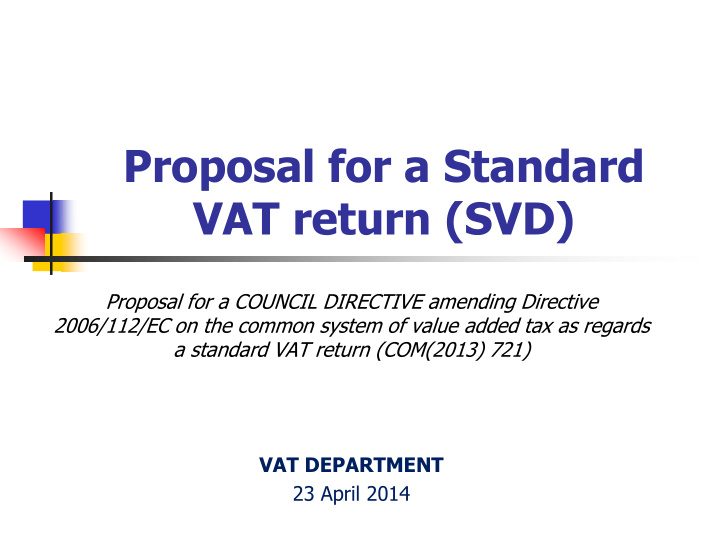



Proposal for a Standard VAT return (SVD) Proposal for a COUNCIL DIRECTIVE amending Directive 2006/112/EC on the common system of value added tax as regards a standard VAT return (COM(2013) 721) VAT DEPARTMENT 23 April 2014
Justification and objectives of the proposal 150 million VAT returns are submitted yearly in the EU The information requested, reporting format and reporting period is different in each Member State Cross-border business activities are increasing Objectives of the proposal: to reduce obstacles to cross border trade and to reduce burdens on domestic businesses in order to support growth and competitiveness. The administrative burden reduction potential for this proposal has been estimated at up to EUR 15 billion per year, most of which for small businesses.
Structure of the SVD SVD replaces all national VAT returns; Proposal provides for the main elements of the SVD but not a SVD form (to be set in the Implementing Regulation); 5 obligatory boxes + 21 box, optional for Member States; Transitional period (until 31 December 2019) is envisaged for information on the total value of supplies and acquisitions of goods within the EU; Taxpayers details (name, address, VAT number etc) shall be established in the Implementing Regulation; Implementing rules including rules of correction of the SVD shall be set in the Implementing Regulation.
Contents of the SVD Only 5 obligatory boxes 21 optional standardized boxes Information for transactions originating in or intended for a specific region or territory for which special rules apply Information covered by a special scheme outside the normal VAT arrangements,
Obligation to submit VAT returns Every taxable person shall submit a SVD Member States may release from the obligation to submit an SVD certain taxable persons Member States may not impose additional invoicing and standard VAT return obligations
Tax period and submission of the SVD Tax period: one calendar month; small businesses up to an established threshold may choose three calendar months (unless one calendar month is needed to prevent tax evasion or fraud in specific cases); Member States may allow longer tax periods (up to one year) in other cases. Submission: deadline determined by Member States (not less than one month and not more than two months, after the end of tax period)
Submission format and payment Format: Member States shall allow, and may require, to submit SVD by electronic means (including electronic file transfer); Payment: when submitting the SVD; in any event at the expiry of the deadline by which the standard VAT return must be submitted.
Commission Implementing Regulation Commission Implementing Regulation shall set the implementing rules of the SVD in particular: the technical details for the transmission of the SVD; a common set of definitions and procedures for the submission of the SVD; common procedures by which corrections can be made to the SVD; common electronic methods offering a sufficient level of security for the submission of the SVD.
Situation Report Proposal is being discussed at the technical level in the Council Certain proposed provisions could be amended in the course of discussions The number of optional boxes could increase to suit the requirements of member states
Questions
Recommend
More recommend